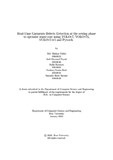| dc.contributor.advisor | Rhaman, Dr. Md. Khalilur | |
| dc.contributor.author | Uddin, Md. Minhaz | |
| dc.contributor.author | Foysal, Sadi Mahmud | |
| dc.contributor.author | Rahman, Sadia | |
| dc.contributor.author | Risti, Nushara Tazrin | |
| dc.contributor.author | Sarmin, Sanzeda Akter | |
| dc.date.accessioned | 2023-08-08T05:39:07Z | |
| dc.date.available | 2023-08-08T05:39:07Z | |
| dc.date.copyright | 2023 | |
| dc.date.issued | 2023-01 | |
| dc.identifier.other | ID: 19101013 | |
| dc.identifier.other | ID: 22241046 | |
| dc.identifier.other | ID: 19141001 | |
| dc.identifier.other | ID: 22241041 | |
| dc.identifier.other | ID: 19101026 | |
| dc.identifier.uri | http://hdl.handle.net/10361/19356 | |
| dc.description | This thesis is submitted in partial fulfillment of the requirements for the degree of Bachelor of Science in Computer Science, 2023. | en_US |
| dc.description | Cataloged from PDF version of thesis. | |
| dc.description | Includes bibliographical references (pages 43-44). | |
| dc.description.abstract | In the era of computer vision to overcome challenges, the introduction of the YOLO
model revolutionized real-time computer vision approaches. In the garment industry,
the inception of products plays a significant role while increasing the processing
time with a good accuracy rate is the big challenge here. A real-time garments
defect detection approach using YOLOv7, YOLOv7x, and YOLOv7-w6 on a primary
dataset is proposed with a good FPS rate and better accuracy. Maximum traditional
garments inception approaches focused on end product defects while this model
suggests detecting defects on the sewing phase so that the cost of the rejected end
product can be optimized by detecting them before a product goes through all
the phases. For this our research is more focused on three subclasses of Seam,
Stitch, and Hole related to sewing phase defects. To increase the detection rate, the
hyperparameter tuning technique is applied to the YOLOv7 model. Three models
are proposed based on pre-trained weights of YOLOv7, YOLOv7x, and YOLOv7-
w6 to compare the accuracy and FPS rate in terms of implementation in real-world
projects. | en_US |
| dc.description.statementofresponsibility | Md. Minhaz Uddin | |
| dc.description.statementofresponsibility | Sadi Mahmud Foysal | |
| dc.description.statementofresponsibility | Sadia Rahman | |
| dc.description.statementofresponsibility | Nushara Tazrin Risti | |
| dc.description.statementofresponsibility | Sanzeda Akter Sarmin | |
| dc.format.extent | 44 pages | |
| dc.language.iso | en | en_US |
| dc.publisher | Brac University | en_US |
| dc.rights | Brac University theses are protected by copyright. They may be viewed from this source for any purpose, but reproduction or distribution in any format is prohibited without written permission. | |
| dc.subject | TILDA | en_US |
| dc.subject | YOLOv7 | en_US |
| dc.subject | YOLOv7x | en_US |
| dc.subject | YOLOv7-W6 CNN | en_US |
| dc.subject | RCNN | en_US |
| dc.subject | DCNN | en_US |
| dc.subject | Faster-RCNN | en_US |
| dc.subject | Neural Networks | en_US |
| dc.subject | Real-Time | en_US |
| dc.subject | Computer vision | en_US |
| dc.subject | Fault | en_US |
| dc.subject | Defect | en_US |
| dc.subject | Detection | en_US |
| dc.subject | Garments | en_US |
| dc.subject | Hole | en_US |
| dc.subject | Stitch | en_US |
| dc.subject | Seam | en_US |
| dc.subject | Roboflow | en_US |
| dc.subject.lcsh | Signal detection. | |
| dc.title | Real-time garments defects detection at the sewing phase to optimize waste cost using YOLOv7, YOLOv7x, YOLOv7-w6 and Pytorch | en_US |
| dc.type | Thesis | en_US |
| dc.contributor.department | Department of Computer Science and Engineering, Brac University | |
| dc.description.degree | B. Computer Science | |




